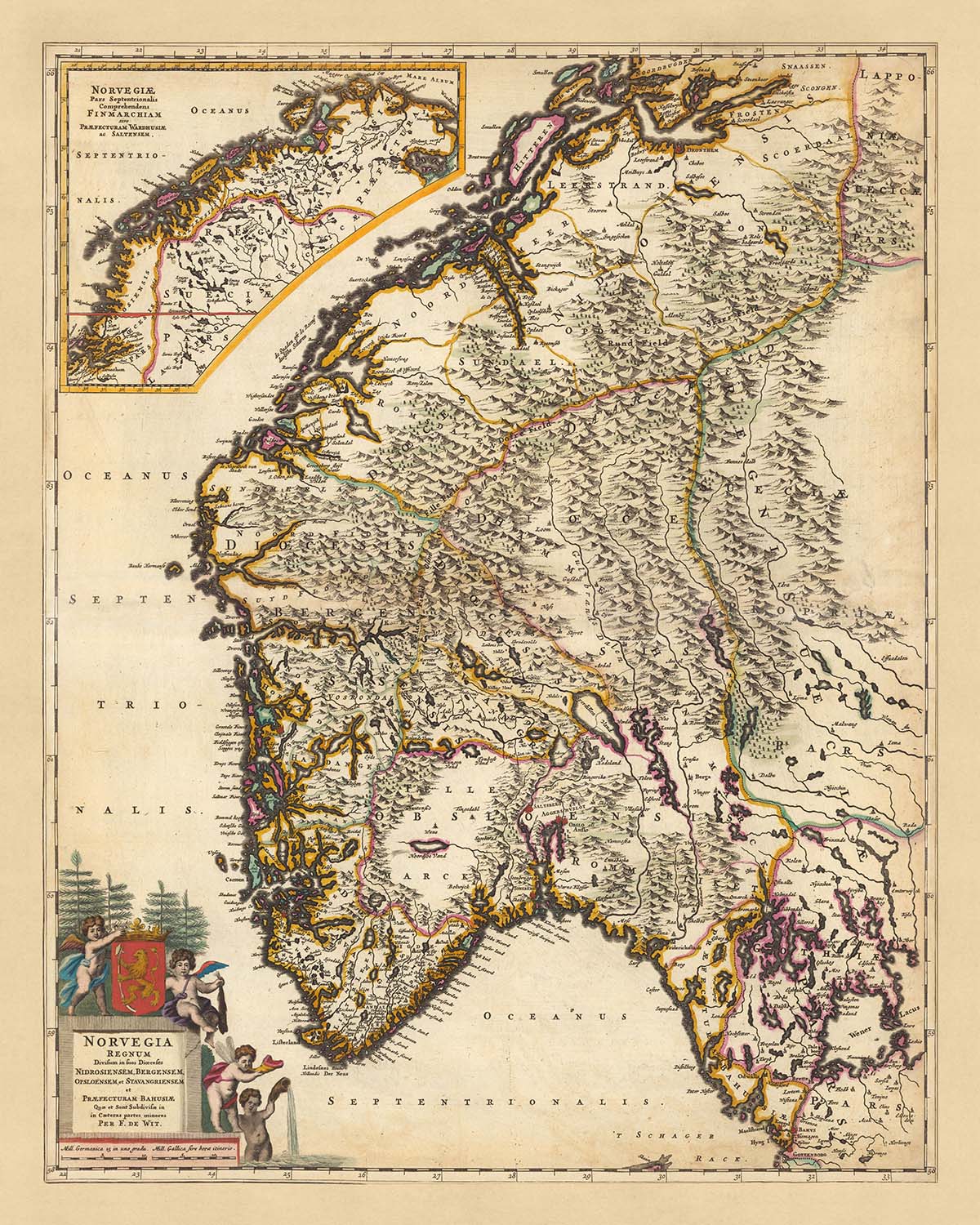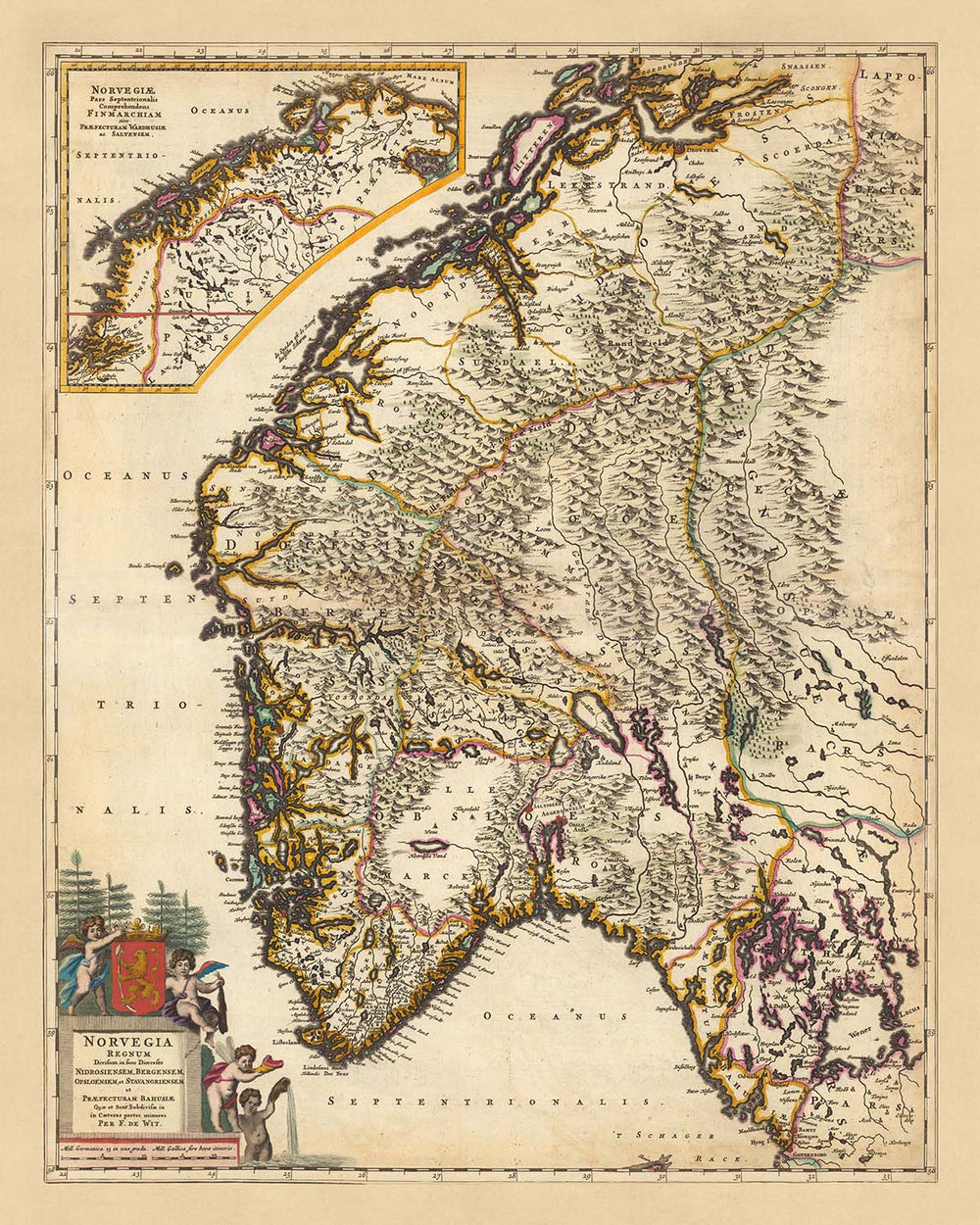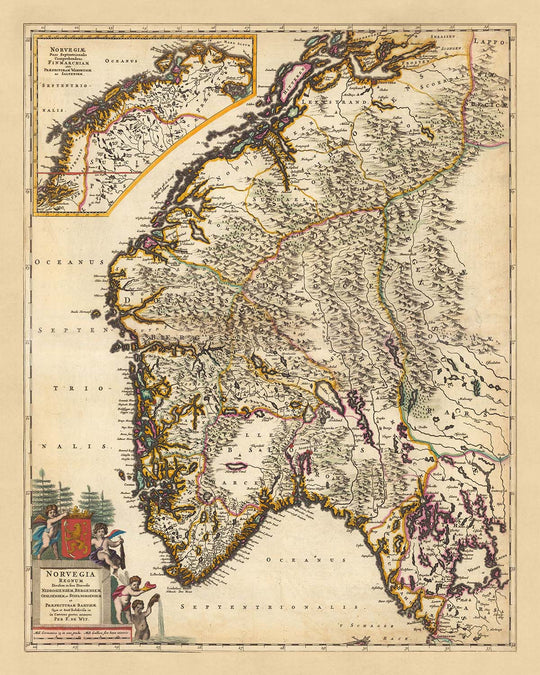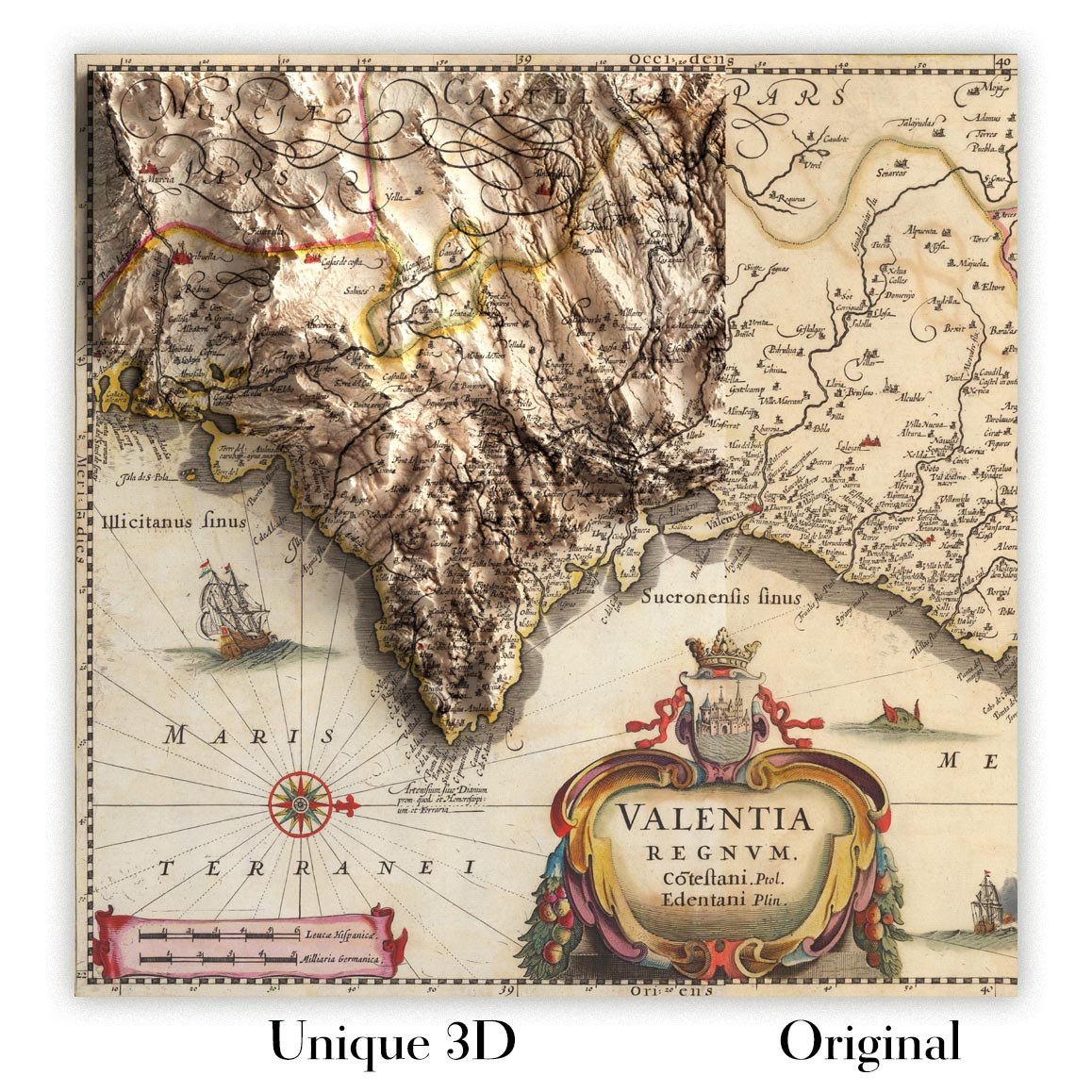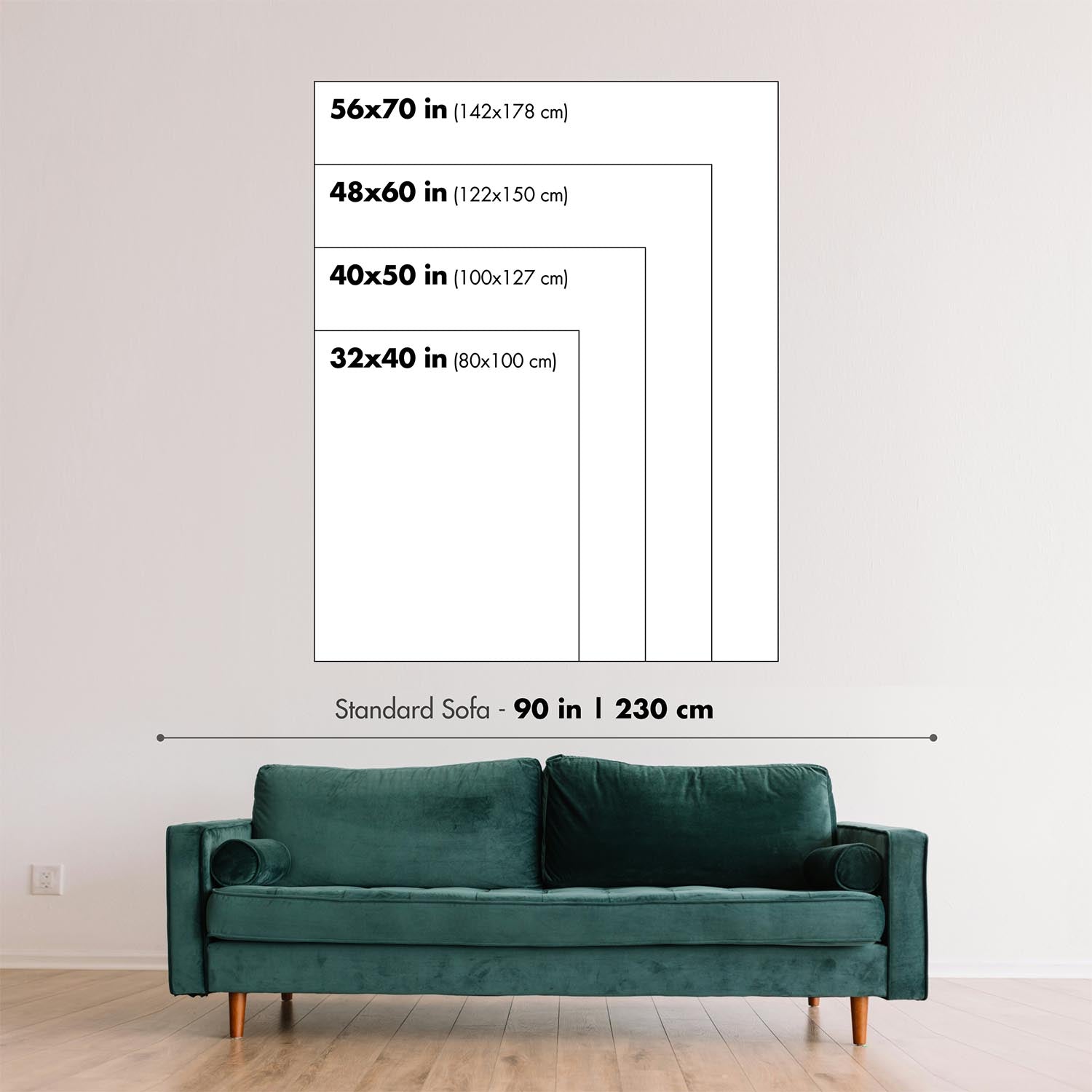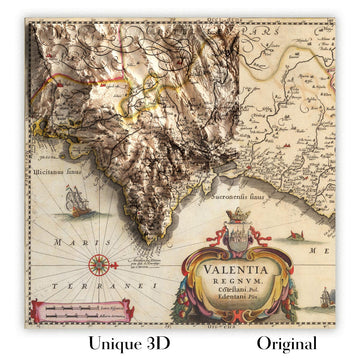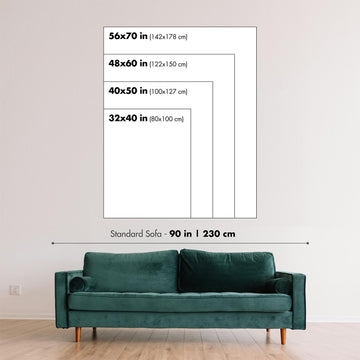- Handmade locally. No import duty or tax
- FREE worldwide delivery
- Love it or your money back (90 days)
- Questions? WhatsApp me any time
Own a piece of history
5,000+ 5 star reviews


This exquisite map, 'Norvegia regnum: divisum in suos dioeceses Nidrosiensem, Bergensem, Opsloensem, et Stavangriensem et praefecturam Bahusiae quae et sont subdivisae in in caeteras partes, minores', is a testament to the meticulous craftsmanship of Nicolaes Visscher II, a renowned mapmaker from the Dutch Golden Age. Created in 1690, the map presents a detailed depiction of Norway, offering a glimpse into the country's historical and political landscape.
The title, translated from Latin, reads 'Kingdom of Norway: divided into its dioceses Nidaros, Bergen, Oslo, and Stavanger and the prefecture of Bohuslän which are further subdivided into other smaller parts'. This translation provides an understanding of the regions covered by the map, revealing its focus on the ecclesiastical and administrative divisions of 17th-century Norway.
The map prominently features the cities of Oslo, Trondheim, Bergen, and Stavanger, each of which holds a significant place in Norway's history. Oslo, the capital, is known for its green spaces and museums, while Trondheim, the country's third-largest city, was the capital of Norway during the Viking Age. Bergen, a city on Norway's southwestern coast, was the largest city in Norway until the 1830s. Stavanger, on the other hand, is known for its preserved old town.
Another notable feature of the map is the Jotunheimen National Park, a popular destination for hiking and climbing due to its high mountain terrain. The park is home to Northern Europe's two highest peaks, Galdhøpiggen and Glittertind, which would have been significant landmarks during the time this map was created. This old map of Norway by Visscher is not just a piece of art, but a window into the past, offering a unique perspective on the country's rich history and geography.
Some of the significant locations shown on this map:
Dioeceses Nidrosiensem (Diocese of Nidaros)
- Trondheim: Known as Nidaros during the Middle Ages, it was the capital of Norway during the Viking Age.
- Steinkjer: Known for its rock carvings from the Iron Age.
- Stjørdal: Known for Stjørdalshalsen, a significant trading post during the Middle Ages.
- Levanger: Known for its annual market which has origins in the Middle Ages.
- Namsos: Known for its timber floating history.
Dioeceses Bergensem (Diocese of Bergen)
- Bergen: Known as Bjørgvin in the Middle Ages, it was the largest city in Norway until the 1830s.
- Stavanger: Known for its preserved old town.
- Haugesund: Known for its proximity to the North Sea.
- Molde: Known as the 'Town of Roses'.
- Kristiansund: Known for its opera festival, the oldest in Norway.
Dioeceses Opsloensem (Diocese of Oslo)
- Oslo: Known for its green spaces and museums.
- Drammen: Known for its river and bridges.
- Fredrikstad: Known for its well-preserved fortress town.
- Sarpsborg: Known for its Viking history.
- Moss: Known for its paper and textile industry.
Dioeceses Stavangriensem (Diocese of Stavanger)
- Sandnes: Known for its pottery history.
- Egersund: Known for its fishing and seafaring history.
- Flekkefjord: Known for its Dutch architectural influence.
- Arendal: Known for its shipping history.
- Kristiansand: Known for its fortress and cathedral.
Praefecturam Bahusiae (Prefecture of Bohuslän)
- Gothenburg: Known for its Dutch-style canals and leafy boulevards.
- Kungälv: Known for the Bohus Fortress.
- Lysekil: Known for its spa history.
- Uddevalla: Known for its shipbuilding history.
- Strömstad: Known for its spa and fishing history.
Some of the significant natural phenomena and boundaries:
- Jotunheimen National Park: Known for its high mountain terrain, including Northern Europe's two highest peaks, Galdhøpiggen and Glittertind.
- Hardangervidda Plateau: Europe's largest mountain plateau.
- Sognefjord: Norway's longest and deepest fjord.
- Norwegian-Swedish border: A significant boundary that has shaped the history of both nations.
- North Sea coastline: Known for its fjords and cliffs.
Notable historical events between 1600 and 1690:
- Kalmar War (1611-1613): A war fought between Denmark-Norway and Sweden.
- Hannibal War (1643-1645): A conflict between Denmark-Norway and Sweden during the Torstenson War.
- Scanian War (1675-1679): A part of the Northern Wars involving Denmark-Norway, Sweden, and Brandenburg.
Please double check the images to make sure that a specific town or place is shown on this map. You can also get in touch and ask us to check the map for you.
This map looks great at all sizes: 12x16in (30.5x41cm), 16x20in (40.5x51cm), 18x24in (45.5x61cm), 24x30in (61x76cm), 32x40in (81.5x102cm), 40x50in (102x127cm), 48x60in (122x153cm) and 56x70in (142x178cm), but it looks even better when printed large.
I can create beautiful, large prints of this map up to 90in (229cm). Please get in touch if you're looking for larger, customised or different framing options.
The model in the listing images is holding the 16x20in (40.5x51cm) version of this map.
The fifth listing image shows an example of my map personalisation service.
If you’re looking for something slightly different, check out my collection of the best old maps of Europe and European cities to see if something else catches your eye.
Please contact me to check if a certain location, landmark or feature is shown on this map.
This would make a wonderful birthday, Christmas, Father's Day, work leaving, anniversary or housewarming gift for someone from the areas covered by this map.
This map is available as a giclée print on acid free archival matte paper, or you can buy it framed. The frame is a nice, simple black frame that suits most aesthetics. Please get in touch if you'd like a different frame colour or material. My frames are glazed with super-clear museum-grade acrylic (perspex/acrylite), which is significantly less reflective than glass, safer, and will always arrive in perfect condition.
This map is also available as a float framed canvas, sometimes known as a shadow gap framed canvas or canvas floater. The map is printed on artist's cotton canvas and then stretched over a handmade box frame. We then "float" the canvas inside a wooden frame, which is available in a range of colours (black, dark brown, oak, antique gold and white). This is a wonderful way to present a map without glazing in front. See some examples of float framed canvas maps and explore the differences between my different finishes.
For something truly unique, this map is also available in "Unique 3D", our trademarked process that dramatically transforms the map so that it has a wonderful sense of depth. We combine the original map with detailed topography and elevation data, so that mountains and the terrain really "pop". For more info and examples of 3D maps, check my Unique 3D page.
For most orders, delivery time is about 3 working days. Personalised and customised products take longer, as I have to do the personalisation and send it to you for approval, which usually takes 1 or 2 days.
Please note that very large framed orders usually take longer to make and deliver.
If you need your order to arrive by a certain date, please contact me before you order so that we can find the best way of making sure you get your order in time.
I print and frame maps and artwork in 23 countries around the world. This means your order will be made locally, which cuts down on delivery time and ensures that it won't be damaged during delivery. You'll never pay customs or import duty, and we'll put less CO2 into the air.
All of my maps and art prints are well packaged and sent in a rugged tube if unframed, or surrounded by foam if framed.
I try to send out all orders within 1 or 2 days of receiving your order, though some products (like face masks, mugs and tote bags) can take longer to make.
If you select Express Delivery at checkout your order we will prioritise your order and send it out by 1-day courier (Fedex, DHL, UPS, Parcelforce).
Next Day delivery is also available in some countries (US, UK, Singapore, UAE) but please try to order early in the day so that we can get it sent out on time.
My standard frame is a gallery style black ash hardwood frame. It is simple and quite modern looking. My standard frame is around 20mm (0.8in) wide.
I use super-clear acrylic (perspex/acrylite) for the frame glass. It's lighter and safer than glass - and it looks better, as the reflectivity is lower.
Six standard frame colours are available for free (black, dark brown, dark grey, oak, white and antique gold). Custom framing and mounting/matting is available if you're looking for something else.
Most maps, art and illustrations are also available as a framed canvas. We use matte (not shiny) cotton canvas, stretch it over a sustainably sourced box wood frame, and then 'float' the piece within a wood frame. The end result is quite beautiful, and there's no glazing to get in the way.
All frames are provided "ready to hang", with either a string or brackets on the back. Very large frames will have heavy duty hanging plates and/or a mounting baton. If you have any questions, please get in touch.
See some examples of my framed maps and framed canvas maps.
Alternatively, I can also supply old maps and artwork on canvas, foam board, cotton rag and other materials.
If you want to frame your map or artwork yourself, please read my size guide first.
My maps are extremely high quality reproductions of original maps.
I source original, rare maps from libraries, auction houses and private collections around the world, restore them at my London workshop, and then use specialist giclée inks and printers to create beautiful maps that look even better than the original.
My maps are printed on acid-free archival matte (not glossy) paper that feels very high quality and almost like card. In technical terms the paper weight/thickness is 10mil/200gsm. It's perfect for framing.
I print with Epson ultrachrome giclée UV fade resistant pigment inks - some of the best inks you can find.
I can also make maps on canvas, cotton rag and other exotic materials.
Learn more about The Unique Maps Co.
Map personalisation
If you're looking for the perfect anniversary or housewarming gift, I can personalise your map to make it truly unique. For example, I can add a short message, or highlight an important location, or add your family's coat of arms.
The options are almost infinite. Please see my map personalisation page for some wonderful examples of what's possible.
To order a personalised map, select "personalise your map" before adding it to your basket.
Get in touch if you're looking for more complex customisations and personalisations.
Map ageing
I have been asked hundreds of times over the years by customers if they could buy a map that looks even older.
Well, now you can, by selecting Aged before you add a map to your basket.
All the product photos you see on this page show the map in its Original form. This is what the map looks like today.
If you select Aged, I will age your map by hand, using a special and unique process developed through years of studying old maps, talking to researchers to understand the chemistry of aging paper, and of course... lots of practice!
If you're unsure, stick to the Original colour of the map. If you want something a bit darker and older looking, go for Aged.
If you are not happy with your order for any reason, contact me and I'll get it fixed ASAP, free of charge. Please see my returns and refund policy for more information.
I am very confident you will like your restored map or art print. I have been doing this since 1984. I'm a 5-star Etsy seller. I have sold tens of thousands of maps and art prints and have over 5,000 real 5-star reviews. My work has been featured in interior design magazines, on the BBC, and on the walls of dozens of 5-star hotels.
I use a unique process to restore maps and artwork that is massively time consuming and labour intensive. Hunting down the original maps and illustrations can take months. I use state of the art and eye-wateringly expensive technology to scan and restore them. As a result, I guarantee my maps and art prints are a cut above the rest. I stand by my products and will always make sure you're 100% happy with what you receive.
Almost all of my maps and art prints look amazing at large sizes (200cm, 6.5ft+) and I can frame and deliver them to you as well, via special oversized courier. Contact me to discuss your specific needs.
Or try searching for something!







